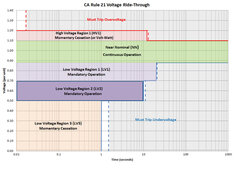Hi ,
i want to extend somewhat the capacity of the PV plant, with a remote group of panels located far away from main PV string and the plant core with 25kWh batteries, hybrid inverter and MPPT chargers. Main plant has 8kW of panels and uses Victron 150/70 and Morningstar Tristar MPPT 150/60 as solar chargers. The hybrid inverter is a cheap chinese toroidal low frequency inverter the (RP6000) rated at 6kW, 18kW surge. The plant will serve two houses, so I will need to add a second inverter, further battery and PV capacity.
I want to use two Hoymiles HM-1500 microinverters to add 6x 415w panels, attaching them directly to the AC side of the offgrid plant. I read that HoyMiles can do frequency shifting, to communicate with other inverters and agree on the amount of AC power to generate and put in the AC circuit.
I read somewhere that Victron Multiplus II, can also implement this "frequency shifting" mechanism on the AC side, so the idea is to add one or two Multiplus 5000VA to the core plant, configuring the Victron to eventually charge the batteries (max 70A DC charging power for each Multiplus), getting extra power from the AC side when available. The chinese toroidal, supposedly not able to do frequency shifting, will be moved to second house with separated AC circuit.
Will this idea work ? Microinverters are getting cheap and efficient, and being able to partially recharge the batteries from extra power generated in the AC side of circuit, is an interesting scenario for me but also others with offgrid plants. Is there a Victron expert that can comment and suggest a minimum configuration to implement this?
Regards, Ugo
i want to extend somewhat the capacity of the PV plant, with a remote group of panels located far away from main PV string and the plant core with 25kWh batteries, hybrid inverter and MPPT chargers. Main plant has 8kW of panels and uses Victron 150/70 and Morningstar Tristar MPPT 150/60 as solar chargers. The hybrid inverter is a cheap chinese toroidal low frequency inverter the (RP6000) rated at 6kW, 18kW surge. The plant will serve two houses, so I will need to add a second inverter, further battery and PV capacity.
I want to use two Hoymiles HM-1500 microinverters to add 6x 415w panels, attaching them directly to the AC side of the offgrid plant. I read that HoyMiles can do frequency shifting, to communicate with other inverters and agree on the amount of AC power to generate and put in the AC circuit.
I read somewhere that Victron Multiplus II, can also implement this "frequency shifting" mechanism on the AC side, so the idea is to add one or two Multiplus 5000VA to the core plant, configuring the Victron to eventually charge the batteries (max 70A DC charging power for each Multiplus), getting extra power from the AC side when available. The chinese toroidal, supposedly not able to do frequency shifting, will be moved to second house with separated AC circuit.
Will this idea work ? Microinverters are getting cheap and efficient, and being able to partially recharge the batteries from extra power generated in the AC side of circuit, is an interesting scenario for me but also others with offgrid plants. Is there a Victron expert that can comment and suggest a minimum configuration to implement this?
Regards, Ugo






